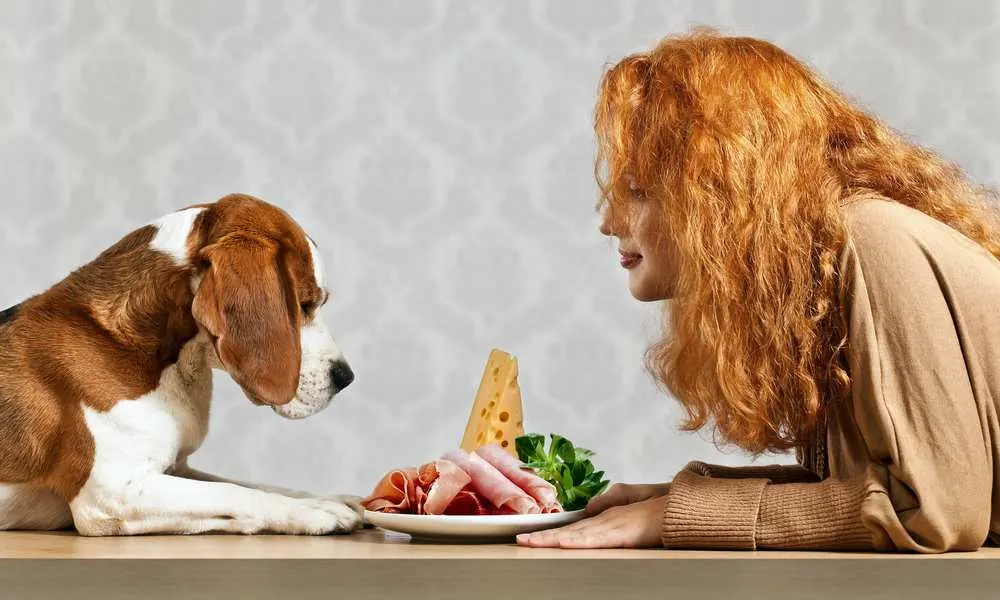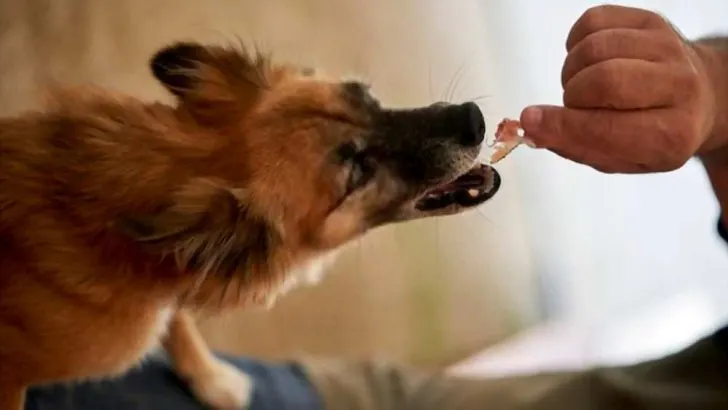Can Dogs Eat Ham? They sure can! Watch your dog’s eyes light up the next time you bring home a tasty round of ham and you will have proof positive that dogs find ham very tasty indeed!
But should dogs eat ham? This is a tougher question to pick apart and examine.
After all, dogs are primarily meat-eaters. Ham is meat. Ham is delicious. And you want your dog to have delicious food and treats and enjoy eating.
But there are some important things you need to know about feeding your dog ham. Read on to get all the information you need about whether dogs can eat ham.

Should Dogs Eat Ham?
The simplest answer to this question is “not really.” But the full answer isn’t quite so simple and comes from understanding the difference between “ham” and “pork.”
Both ham and pork come from pigs. But ham comes only from a pig’s hind leg.
On its own, before curing, smoking, salting, or seasoning, this cut of meat isn’t the highest fat portion of the pig. But even so, as we will explain, ham, in general, isn’t the ideal protein source for your pet dog.

Is Ham Safe For Dogs?
As the American Kennel Club (AKC) explains, the way most grocery store ham is prepared is to “cure” it by smoking it and then adding lots of sodium as a preservative and flavor enhancer.
This makes ham, at least as it is sold commercially, very unhealthy food for dogs.
The truth is, lots of sodium isn’t good for anyone, least of all your dog. As Medical News Today points out, the high sodium content isn’t the only unhealthy thing about feeding your dog ham.
Grocery store ham is also high in fat – and not the “good” kind of fat that some protein sources like salmon can serve up.
Dogs, like people, need some “good” fat and the essential fatty acids that come along with it.
These essential fatty acids will help keep your dog’s skin and coat healthy, reduce systemic inflammation, protect the eyes and the heart, help manage weight, and can even protect against cancer and yeast infections, according to PetMD.
But ham isn’t the right meat to give your dog to increase the amount of essential fatty acids intake. According to Canine Journal, the type of fat found in all pork, including ham, is hard for dogs to digest.

Is Ham Dangerous For Dogs?
The bad news here is, ham is not just unhealthy for dogs, but it can actually be a dangerous food choice for your pup.
There are three main dangers you need to watch out for:
- Inflammation or pancreatitis.
- Choking, perforation, or impaction.
- Trichinosis.
Let’s take a look at each one now.
1. Pancreatitis (Inflammation Of The Pancreas)
Pancreatitis is a relatively common acute health condition that dogs can suffer from.
As VCA Animal Hospital explains, when your dog’s diet is high in fat, this can inflame the pancreas and cause the digestive enzymes this organ produces to overreact and start digesting everything in sight before they reach the intestinal system.
This causes a range of symptoms including these:
- Nausea.
- Fever.
- Fatigue.
- Vomiting.
- Diarrhea.
- Dizziness.
- Pain or bloating (especially in the abdomen).
- Loss of appetite.
- Shock.
- Sudden depression.
- Posture changes (hindquarters in the air and face on the ground).
- Death.
Fatty foods are a primarily known trigger for pancreatic inflammation and acute pancreatitis. This is a concern when feeding ham to your dog even when you factor out the sodium and carcinogens from the smoking process.
2. Choking, Perforation Or Impaction
Hambones will not look (or smell) tempting to your pup. The thick, meaty hind hock bone can appear like an ideal treat to keep your dog busy and out of the kitchen.
Unfortunately, you don’t ever want to feed ham bones to your dog. Cooked bones of any kind are seriously dangerous and can splinter as your dog chews, causing perforations, internal bleeding, and even death.
But raw ham bones are equally dangerous for another reason, which is what we will cover in the next section here.
The symptoms of choking are obvious and you will want to watch closely for these if you suspect or know your dog ate a ham bone, raw or cooked.
But what symptoms can you watch for if you are worried about perforation (internal bleeding) or impaction (intestinal or bowel obstruction)?
Watch for these symptoms:
- Constipation.
- Abdominal bloating or pain.
- Gas.
- Pale or white gums.
- The cool temperature on legs, tail, ears.
- Coughing that produces blood or wheezing.
- Weakness or collapse.
- Rapid or weak heartbeat.
- Blood in urine or feces.
The same symptoms, along with hunching or whining, can be indicative of an obstruction in the intestines or the bowel. If you see any of these symptoms after your dog eats ham or pork, it is time to head for the nearest veterinary urgent care clinic.
3. Trichinosis (Pork Roundworm)
Trichinosis is a kind of parasite that is found in many types of meat and is especially common in parks.
PetMD explains that trichinosis is also called trichinellosis or trichiniasis.
The parasite, a roundworm, is a kind of nematode called Trichinella spiralis (T. spiralis). The roundworm may be found in uncooked (raw), undercooked, or contaminated meat, including and especially pork and ham.
Trichinosis is very dangerous for you as well as for your dog. The parasite will migrate from the stomach to the muscles and cause intense cramping, inflammation, and, in severe cases, death. The roundworm is very difficult to get rid of once your dog is infected.
Roundworm is also expensive to treat, requiring ongoing testing (urine, blood, fecal) as well as treatment until all tests come back negative.

So, Can Dogs Eat Ham?
Of course, you may be reading this article right now because your dog just ate some ham and you are not sure if it is safe.
So the big question on your mind may well be, “how worried should I be?”
The best answer is that it depends on your answers to these three questions:
- What part did your dog eat?
- How much did your dog eat?
- How long ago did your dog eat it?
Dogs can potentially eat a lot of things that they shouldn’t be eating. You already know this all too well! It is often quite hard to stop a dog from feasting on things that range from mildly off-limits to stomach-turning (in people).
If your dog ate a small cube of ham meat – not the fat trimmings, not the cooked ham bone, and not the raw ham bone – and it was a while ago and you don’t see any symptoms or warning signs, it is likely not a big deal.
However, if your dog is a toy or miniature breed, has a known history of a sensitive stomach, is overweight or obese, has ever suffered from pancreatitis in the past, or is even now drinking water like mad, it is smart to call your veterinarian anyway.
If you have any questions at all or feel worried, a call to your dog’s veterinarian is always the smartest course of action.
If your dog is at the fat trimmings or any part of a cooked or raw ham bone, you will want to watch closely for the next several hours for signs of the health symptoms we listed here earlier.
Monitor these things in particular:
- How much water is your dog drinking and is that amount normal?
- Does your dog seem to have normal energy?
- Do you see normal bathroom habits (urine, feces)?
Because the side effects of eating ham can come on suddenly and be very painful or life-threatening, you never want to wait if you see that your dog is in distress.
Some dogs seem to have the proverbial “iron stomach” and nothing bothers them. Other dogs are so sensitive they can’t tolerate any deviation from their normal diet (no matter how delicious it was and how much they wanted to eat it).
You know your dog best. Always call your vet when in doubt.
Learn More: What Can Dogs Eat? A Comprehensive List Of Dog-safe Foods


